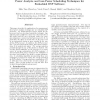Free Online Productivity Tools
i2Speak
i2Symbol
i2OCR
iTex2Img
iWeb2Print
iWeb2Shot
i2Type
iPdf2Split
iPdf2Merge
i2Bopomofo
i2Arabic
i2Style
i2Image
i2PDF
iLatex2Rtf
Sci2ools
ISSS
1995
IEEE
1995
IEEE
Power analysis and low-power scheduling techniques for embedded DSP software
This paper describes the application of a measurement based power analysis technique for an embedded DSP processor. An instruction-level power model for the processor has been developed using this technique. Signi
cant points of di
erence have been observed between this model and the ones developed earlier for some general-purpose commercial microprocessors [1, 2]. In particular, the e
ect of circuit state on the power cost of an instruction stream is more marked in the case of this DSP processor. In addition, the DSP processor has a special architectural feature that allows instructions to be packed into pairs. The energy reduction possible through the use of this feature is studied. The on-chip Booth multiplier on the processor is a major source of energy consumption for DSP programs. A micro-architectural power model for the multiplier is developed and analyzed for further energy minimization. A scheduling algorithm incorporating these new techniques is proposed to reduce the energ...
| Added | 26 Aug 2010 |
| Updated | 26 Aug 2010 |
| Type | Conference |
| Year | 1995 |
| Where | ISSS |
| Authors | Mike Tien-Chien Lee, Vivek Tiwari, Sharad Malik, Masahiro Fujita |
Comments (0)

